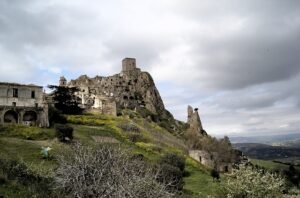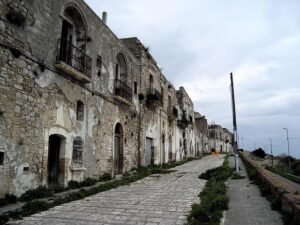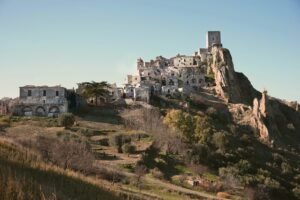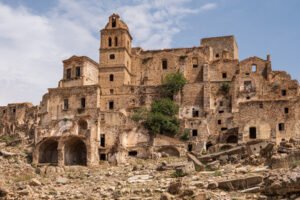Craco is one of the most intense places you can see in the south. And it is almost always a solitary sight. It is you and the country that no longer exists. (Franco Arminio)
Craco
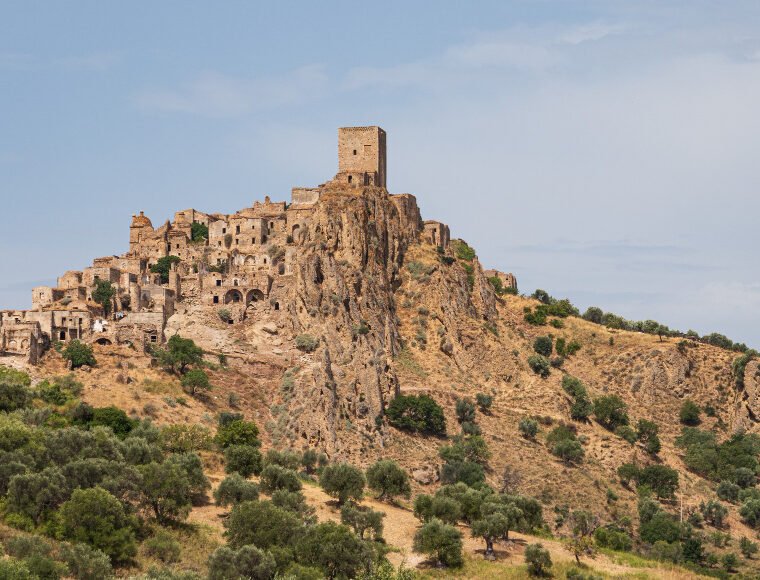
The village of Craco, which survived for a thousand years surrounded by the landscape of the gullies and erected on a rocky spur dominating the valley of the Salandrella torrent, is today a silent ghost town that suggestively preserves intact its ancient remains, completely enveloped in a halo of timeless charm. Craco's history has very ancient origins: its territory, most likely already frequented by the Magno-Greek settlers from Metaponto, hosted a Byzantine settlement in the 10th century that favoured the development of an urban centre with dwellings perched around the high quadrangular tower, a strategic viewpoint over the valley of the Cavone and Agri rivers. The village, alive and flourishing, over the centuries underwent several changes of ownership until it became part of the territories that experienced the French Decade; finally, following the Unification of Italy, it was the scene of brigandage, a phenomenon that affected many towns in southern Italy. Until 1963, Craco was a populated village: its depopulation occurred gradually over the years, first following a landslide in 1963 and then due to a flood in 1972 that discouraged any form of repopulation. Today, Craco is to all intents and purposes a ghost town, a feature that, together with its characteristic conformation, makes it a world-famous destination, several times the location for numerous film productions (such as The Passion by M. Gibson and Basilicata coast to coast by R. Papaleo).
The village of Craco, during a visit, offers truly emotional experiences that will immediately take you to a distant dimension, where everything has remained suspended as it was years and years ago. Strolling among the abandoned buildings and palaces, until you reach the ancient Norman tower where you can admire the view will give you unique sensations, amidst the silence of the village completely enveloped by the incredible gullies. At present, independent visits are not permitted and visitors must be accompanied by a guide who will show all the most interesting buildings, constructions and views, such as Palazzo Maronna, in the immediate vicinity of the tower; Palazzo Grossi and the nearby Mother Church dedicated to San Nicola; the 15th-century Palazzo Carbone with its monumental entrance; the remains of the small church of S. Eligio (located in the contrada of the same name), which preserves part of a fresco dating back to the 16th century; or the 'Canzoniere' contrada, which owes its name to a legendary tavern of the same name, run by a woman who seduced patrons and then murdered them and pickled them, thus preparing the tavern's main dish!
You can taste the traditional flavours of Craco in restaurants, trattorias and genuine agritourisms in the nearby villages. The characteristic dishes are those of the Val d'Agri: Vegetable-based dishes such as stuffed peppers and aubergines or those based on pulses and cereals are typical, while first courses include the inevitable handmade grilled pasta or tagliatelle with breadcrumbs. Meat processing has a long and well-established tradition in the area and can be enjoyed in dishes such as pan-cooked lamb or the typical Lucanian ragout. Finally, if you get the chance, try lampascioni: bulbs similar to spring onions but with a bitterish aftertaste, and don't miss Canestrato di Moliterno, a slightly spicy IGP (Protected Geographical Indication) ripened cheese. For dessert, fried figs or calzoncelli filled with chickpeas and chestnuts will be perfect.
The traditional event that takes place in Craco is the Feast of St Nicholas, which falls on the second Saturday in October. For the occasion, musical events are held in addition to the religious ceremony, attended by travellers and inhabitants of neighbouring towns. Another event of similar magnitude is the Feast of Our Lady of the Star, which is celebrated during the first half of August. On this occasion, too, the sacred event is enriched by musical events attended by a large audience.
